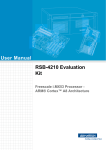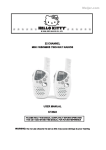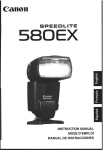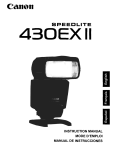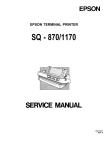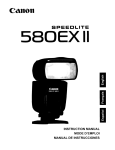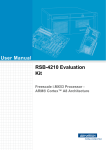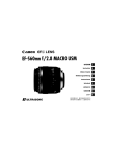Download Canon Camera Accessories SBOEX User's Manual
Transcript
Canon
SPEEDLITE
SBOEX
INSTRUCTION MANUAL
MODE D'EMPLOI
MANUAL DE INSTRUCCIONES
Thank you for purchasing a Canon product.
The Canon Speedlite 580EX is an EOS-dedicated, high-output flash unit
automatically compatible with E-TTL II, E-TTL, and TTL autoflash. It can be
used in three different ways: As a normal on-camera flash, the master unit
for a wireless, multi-Speedlite flash system, or a slave unit.
Read this instruction manual while also referring to your camera's
instruction manual.
Before using the Speedlite, read this instruction manual and your camera's
instruction manual to familairize yourself with the Speedlite operations.
The basic operation is the same as with normal AE shooting.
When the 580EX is attached to an EOS camera, almost all automatic
exposure control for flash photography is handled by the camera.
It is almost the same as using the camera's built-in flash if it has one.
You can think of the 580EX as a built-in, high-output flash.
It is automatically compatible with the camera's flash metering mode
(E-TTL II, E-TTL, and TTL).
The camera controls the Speedlite automatically in the following flash metering
modes:
1. E-TTL II autoflash (evaluative flash metering with preflash reading/lens
distance information)
2. E-TTL autoflash (evaluative flash metering with preflash reading)
3. TTL autoflash (off-the-film metering for real-time flash metering)
Regarding the camera's available flash metering modes, refer to the
camera's instruction manual. The Speedlite's major specifications are
listed in "External Flash Items."
The camera instruction manual's chapter on flash photography will refer to
cameras having 1 and 2 as a Type-A camera (compatible with E-TIL or
E-TTL II). And cameras having 3 (compatible with only TTL) are called
Type-B cameras.
* This instruction manual assume that you are using the 580EX with a
Type-A camera.
For Type-B cameras, see page 53.
2
Contents
1 Getting Started and Basic Operation
7
2 Using Flash
13
3 Wireless Flash
31
4
45
Reference...
Conventions Used in this Manual
The <@> symbol in the text refers to the Select Dial.
The <@> symbol in the text refers to the Select/Set button.
The operation procedures in this instruction manual assume that both the
camera and Speedlite's power switches are ON.
Icons are used in the text to indicate the respective buttons, dials,and settings.
They match the same icons found on the camera and Speed lite.
The (08) / (012) icons indicate that the respective function remains in effect
for 8 sec. or 12 sec.
Reference page numbers are indicated by (p. **).
This instruction manual uses the following alert symbols:
__ : The Caution symbol indicates a warning to prevent shooting problems.
[]] : The Note symbol gives supplemental information.
3
Nomenclature
Flash head/
Wireless
transmitter
Wireless sensor
I.---H--
External power
source socket
Canon
SPEEDLITE S80EX
AF-assist beam emitter
(pA7)
Mounting foot (p.9)
Case
4
_~~I!t~t~i----
Locking ring (p.9)
Mini stand
LCD panel
Bounce angle
<PUSH>
Bounce lock release
button (p.18)
~~~~I
.------+-i-7::~- < ~H / ~ >
High-speed sync (FP flash)/
Shutter curtain synchronization
button (p.17/26)
* <;.~.:/C.Fn>
LCD panel illumination/
Custom Function setting
button (p.6/27)
<PILOT>
Pilot lampfTest firing/ Wireless
slave auto power off cancel
button (p.1 0/35)
Flash exposure confirmation
lamp (p.11)
<@> Select Dial
<MODE>
Flash model Slave
setting button (p.11,
22, 24/42, 43)
*
[l]
<@> Select/Set button
Wireless selector (p.9, 34)
<OFF>
: Wireless off (for on-camera flash)
<MASTER> : Master unit
<SLAVE>
: Slave unit
Asterisked buttons have a timer that keep the button's function active for
8 sec. (08) after you let go of the button. The <:,~:-> illumination lasts for
12 sec.
5
LCD Panel
Manual flash output level
Flash exposure compensation amount
FEB compensation amount
Zoom focal length
Aperture FEB status
Stroboscopic flash count
Stroboscopic flash frequency
Manual flash 1/3-stop increment
indicator
Custom Function No.
Custom Function setting
< ~ > Manual zoom
< '!I> High-speed sync
(FP flash)
< ~ > Auto zoom
for image size
<ETTLlTTl>
E-ITL (II)/ITL
autoflash
<~> ----+1-(2
~TLITO.'~'/Z~OI~~~,?~mn§
:S8 .OOT.O.OHz
I
Flash exposure
compensation
M
0
lim ~ "'z.~.
·
1 2 3 4
0.5 0.7 1 1.5 2
<M/MulTl>
Manual flash/ Multi
(Stroboscopic) flash
~ 2.31 4
<~>
Custom Function
<~>
A:B:c
r----',--
Ul1!,. i 3 1K(.
3
4
..
•
6 ,9
"'r"
T
13 18 m
Flash ratio
I
I
Flash range scale/
Flash ratio scale
I
I
Indicator (meters)
--.1
I
I
Firing mode
Master flash ON : 4.~
Master flash OFF : *~
Slave flash
: ~~
I
Indicator (feet)
L
<liMit.W> Flash ratio
< ..11M- > Slave
1
< .. > Flash bounce indicator
,_I_
<_11:_> Channel
(Blinks for 7 down)
To illuminate the LCD panel, press the < ~f?:. > button.
s' The items actually displayed depend on the current settings.
6
)
I
I
Second-curtain sync
@
Slave 10
"'r"
5' 7 1C~~m 40 60 f~
Slave 10
I
Getting Started and
Basic Operation
Installing Batteries
8
Attaching to the Camera
9
Turn on the Power Switch
10
Fully Automatic Flash Shooting............................ 11
Using E-TTL II and E-TTL Autoflash in the
Shooting Modes
12
(»
To avoid overheating and deteriorating the flash head, do not fire rapid
bursts of more than 20 continuous flashes. After 20 continuous flashes,
allow a rest time of at least 10 min.
Installing Batteries
Install four size-AA batteries.
1
%1
Open the cover.
~.
Slide the battery compartment cover as
shown by the arrow and open it.
Install the batteries.
Make sure the + and - battery contacts are
correctly oriented as shown in the battery
compartment.
Close the cover.
Close the battery compartment cover and
slide it as shown by the arrow.
Recycling Time and Flash Count (with size-AA alkaline batteries)
Recycling Time (Approx.)
Quick Flash
0.1 - 3
....
Normal Flash
0.1 - 6
Flash Count(Approx.)
100 - 700
"" Based on new size-AA alkarine batteries and Canon's testing standards.
$ Quick flash enables a flash to be fired before flash-ready (p.1 0).
Since the shape of their contacts is not standardized, using non-alkaline size-AA
batteries may result in faulty battery connection.
!lJ
'iii
@
8
Use four new batteries of the same brand and type. Do not mix battery types. When
replacing batteries, replace all four batteries at the same time.
Size-AA Ni-MH or lithium batteries can also be used.
Attaching to the Camera
~~~~' .•.• • •. •. I
~t
.ii]
Loosen the locking ring.
WI
Turn the locking ring as shown by the arrow
to loosen it.
Attach it to the camera.
@@
Slip the Speedlite's mounting foot all the
way into the hot shoe.
Tighten.
@
Turn the locking ring as shown by the
arrow. The locking pin will protrude from
the mounting foot to further secure the
attachment.
To detach the Speedlite, loosen the locking
ring until the locking pin disengages. Then
slip the Speedlite out of the hot shoe.
Wireless Selector Settings
The wireless selector is for switching between
normal flash shooting and wireless flash
shooting.
For normal flash shooting, be sure to set the
wireless selector to <OFF>.
9
Turn on the Power Switch
@E~~Z6OJ~-~~
ttMt
Fjd
H'
liPi
1 Set the power switch to <ON>.
,
l>
The flash will start recycling.
Check that the flash is ready.
~
~
The pilot lamp will first turn green (ready for
quick flash), then red (fully recycled or flash
ready).
To fire a test flash, press the pilot lamp.
About Quick Flash
Quick flash enables a flash to be fired before flash-ready, when the pilot lamp
is still green.
Although the Guide No. will be 1/6 to 1/2 that of the full output, quick flash is
effective for near subjects and when you want a shorter recycle time.
Set the drive mode to Single. Quick flash cannot be used in the continuous
shooting, FEB, manual flash, and stroboscopic flash modes.
About Auto Power Off
To save battery power, the power will turn off automatically after 90 sec. of
idle use. To turn on the Speedlite again, press the shutter button halfway.
Or press the Speedlite's test firing button.
[l] .; . A test firing cannot be fired while the camera's operation timer 04 or 06 is active.
1$
10
The Speedlite's settings will be retained in memory even after the power is turned off.
To retain the Speedlite's settings when you replace the batteries, replace the batteries
within 1 minute after turning off the power.
Fully Automatic Flash Shooting
When you set the camera's shooting mode to <P> (Program AE) or <0>
(Full Auto), E-TTL II/E-TTL fUlly automatic flash will make it as easy as
normal AE shooting.
Zoom
SOmm
1
ru.
0.5 0.7 1 1.5 2
3
4
Set the Speedlite to <ETTl>.
~
Press the <MODE> button so that
<ETTL> is displayed.
9 13 18 m
6
Focus the subject.
IS},
~\}o
ETTL
Zoom
SOmm
-------
0.5 0.7 1 1.5 2
3
4
6
9 13 18 m
Take the picture.
~
~
~>
I.lJ
0
Press the shutter button halfway to focus.
The shutter speed and aperture will be set
as displayed in the viewfinder.
Check that the < ~ > icon is lit in the
viewfinder.
Check that the subject is within the
effective range displayed on the LCD
panel.
A preflash is fired right before the shot is
taken, then the main flash is fired.
If a standard flash exposure was obtained,
the flash exposure confirmation lamp will
light for about 3 sec.
<ETTL> will be displayed on the
LCD panel even if the camera is compatible with
E-TTL II.
If the flash exposure confirmation lamp does not light, move closer to the subject and
take the picture again. You can also increase the camera's ISO speed.
11
Using E-TTL II and E·TTL Autoflash in the Shooting Modes
Ii
Just set the camera's shooting mode to <Av> (aperture-priority AE), <Tv>
(shutter-priority AE), or <M> (manual) and you can use E-TTL II/E-TTL
autoflash.
Tv
..
Av
Select this mode when you want to set the aperture manually.
The camera will then automatically set the shutter speed matching the aperture to obtain
a standard exposure.
If the background is dark like a night scene, a slow sync speed will be used to obtain a
standard exposure of both the main subject and background. Standard exposure of the
main subject is obtained with the flash, while a standard exposure of the background is
obtained with a slow shutter speed.
e Since a slow shutter speed will be used for low-light scenes, using a tripod is
recommended.
$ If the shutter speed display blinks, it means that the background exposure will be
underexposed or overexposed. Adjust the aperture until the shutter speed display
stops blinking.
M
Select this mode when you want to set both the shutter speed and aperture manually.
Standard exposure of the main subject is obtained with the flash. The exposure of the
background is obtained with the shutter speed and aperture combination you set.
I
$
Select this mode when you want to set the shutter speed manually.
The camera will then automatically set the aperture matching the shutter speed to obtain
a standard exposure.
@ If the aperture display blinks, it means that the background exposure will be
underexposed or overexposed. Adjust the shutter speed until the aperture display
stops blinking.
If you use the <DEP> or <A-DEP > shooting mode, the result will be the same as using the
<P> (Program AE) mode.
Flash Sync Speeds and Apertures Use
Shutter SPE!E!cJ§E!tting
Aperture Setting
p
Automatic (1/60 sec. - 1/X sec.)
Automatic
Tv
Av
Manual (30 sec. - 1/X sec.)
Automatic
Automatic (30 sec. - 1/X sec.)
Manual
M
Manual (bulb, 30 sec. - 1/X sec.)
Manual
o 1/X sec. is the camera's maximum flash sync speed.
12
Using Flash
~ Flash
Exposure Compensation.......................
~ FEB (Flash Exposure Bracketing)...........
FE L FE Lock
~ High-Speed Sync (FP Flash)
Bounce Flash
ZOOM Setting the Flash Coverage and Using
the Wide Panel.....................................................
M Manual Flash..................................................
MULTI Stroboscopic Flash...................................
~ Second-Curtain Sync.....................................
C.Fn Setting Custom Functions
Custom Function Settings
14
15
16
17
18
20
22
24
26
27
28
~ Flash
Exposure Compensation
You can adjust the flash output as easily as normal exposure
compensation. Flash exposure compensation can be set up to ± 3 stops in
1/3-stop increments. (If the camera enables only 1/2-stop increments, then
only 1/2-stop increments can be set.)
1 Press the
<~>
button so that the
<~> icon and flash exposure
compensation amount blink.
Set the flash exposure
compensation amount.
Turn the <€» dial to set the amount.
%# To cancel the flash exposure compensation,
set the amount to +0.
$f
''- Press the <~> button.
~
[l]
14
~
The flash exposure compensation amount
will be set.
If flash exposure compensation has been set with both the Speedlite and camera, the
Speedlite's flash exposure compensation amount will override the camera's.
~ FEB (Flash Exposure Bracketing)
ii&:W
You can take three flash shots while automatically changing the flash
output for each shot up to ±3 stops in 1/3-stop increments (1/2-stop
increments if the camera enables only 1/2-stop increments). This is called
FEB (Flash Exposure Bracketing).
1 Press the < ® > button so that the
<~>
icon and flash exposure
bracketing amount blink.
E""C1iL, ,
I ,
ZO
-~-O-
'.'''1'
Set the flash exposure bracketing
amount.
&
Turn the <@> dial to set the amount.
3 Press the <@> button.
1>- FEB will be set.
[l]
a After all three shots are taken, FEB will be canceled.
@ The shots will be taken in the drive mode set with the camera.
@ For FEB shooting, set the camera's drive mode to Single shooting and be sure the
flash is ready before you shoot.
* You can also combine FEB with flash exposure compensation and FE lock.
15
FE L FE Lock
FE (flash exposure) lock enables you to lock the correct flash exposure for
any part of the picture.
With <ETTL> displayed on the LCD panel, you press the camera's
<FE L> button. If the camera does not have the <FE L> button, press the
<*> button.
1 Focus the subject.
Press the <FE L> button. (816)
BODO
0000000
000
oo 000 000
~, 000
00000
0
lJf:
~
~.
$I
4)
16
Aim the viewfinder center over the subject
and press the <FE L> button.
A preflash will be fired to obtain a flash
exposure reading for the subject.
"FEL.:' will be displyed on the LCD panel for
0.5 sec.
Each time you press the <FE L> button, a
preflash will be fired and a new flash
exposure reading will be locked.
If the subject is too far away and underexposure will result, the < ~ > icon will blink in
the viewfinder. Move closer to the subject and try the FE lock again.
(} If < ETTL> is not displayed on the LCD panel, FE lock will not be possible.
@ If the subject is too small, FE lock might not be very effectiv~.
'10
~ High-Speed
Sync (FP Flash)
With high-speed sync, you can use flash with all shutter speeds. This is
convenient when you want to use aperture priority for fill-flash portraits.
Ell ~
50mm
Zoom
Press the <~H/~> button so that
<~> is displayed.
~
Check that the <~H> icon is lit in the
viewfinder.
0.5 0.7 1 1.5 2
3
4
6
9
13 18 m
s;} Stroboscopic flash cannot be set.
[i/0 If you set a shutter speed that is the same or slower than the camera's maximum flash
$)
sync speed, < ~H > wi! not be displayed in the viewfinder.
With hjgh~speed sync, the faster the shutter speed, the shorter the effective flash
range will be. Check the LCD panel for the effective flash range.
To return to normal flash, press the <~H/~> button so that <~> icon turns off.
17
Bounce Flash
By pointing the flash head toward a wall or ceiling, the flash will bounce off
the surface before illuminating the subject. This can soften shadows behind
the subject for a more natural-looking shot. This is called bounce flash.
Set the Bounce Direction
Hold down the <PUSH> button and turn the flash head.
If the flash coverage is set automatically, the flash coverage will be set to
50mm.
The LCD panel will also display <- -> mm.
15)1 You can also set the flash coverage manually_
If the wall or ceiling is too far away, the bounced flash might be too weak and result in
underexposure.
*' The wall or ceiling should be a plain, white color for high reflectance. If the bounce
surface is not white, a color cast may result in the picture.
<)i After you take the shot, if the flash exposure confirmation lamp does not light, use a
larger aperture opening and try again.
$
18
Creating a Catchlight
With the catchlight panel, you can create a catchlight in the subject's eyes to
add life to the facial expression.
1(I
Point the flash head upward by 90°.
Pull out the wide panel.
l? The catchlight panel will come out at the
same time.
Push in the wide panel.
#P
~
U
Push in only the wide panel.
Follow the same procedure as for bounce
flash.
Point the flash head straight ahead and then upward by 90 0 • The catchlight will not
work if you swing the flash head left or right.
*' For maximum catchlight effect, stay within 1.5 m/4.9 ft of the SUbject.
@
Closeup Flash Shooting
If you want to shoot a subject about 0.5 - 2 m (1.6 - 6.6 ft) away, hold down
the <PUSH> button and tilt the flash head downward by 7°.
Zoom
ETTL
" I ,
-
IE)
5Dmm
F- S.b
1-
---(------
- - - / - 1',\-\-'7,.0.5 0.7 1 1.5
2"314,
,;\~13
18 m
19
ZOOM Setting the Flash Coverage and Using the Wide Panel
III
The flash coverage can be set to match the lens focal length from 24mm to
105mm. The flash coverage can be set automatically or manually. Also,
with the built-in wide panel, the flash coverage can be expanded to 14mm
wide-angle lenses.
ETTL
mil Zoom 2l.f mm
Press the
11&)
~
0.5 0.7 1 1.5 2
3
4
6
9 13 18 m
<ZOOM/~>
button.
Turn the <@> dial to change the flash
coverage.
When the flash coverage is set
automatically, <1m> is not displayed.
[]] If you set the flash coverage manually, make sure it covers the lens focal length so that
the picture will not have a dark periphery.
Using the Wide Panel
Pull out the wide panel and place it over the
flash head as shown. The flash coverage
will then be extended to 14mm.
The catchlight panel will come out at the
same time. Push the catch light panel back
in.
~ The <ZOOM/~> button will not work.
@
$,
@
If you use bounce flash with the wide panel in place, the entire display on the LCD
panel will blink as a warning. Since the subject will be illuminated by both the bounce
flash and direct flash, it will look unnatural.
Pull out the wide panel gently. Using excessive force may detach the wide panel.
If the wide panel is accidentally detached, the
<ZOOM/~> button will not work. The zoom
feature will work again when you press the spot
shown by the arrow. The entire display on the
LCD panel will blink, but the Speedlite will work
normally.
[]] The flash coverage will not be compatible with the EF15mm f/2.8 Fisheye lens.
20
Automatic Setting of Flash Coverage for the Camera's Image Size
EOS digital cameras have one of three image sizes. The lens' effective focal
length will differ depending on the camera's image size. The Speedlite
automatically recognizes the EOS digital camera's image size and
automatically sets the flash coverage for lens focal lengths from 24mm to
105mm.
When the Speedlite is attached to a compatible camera, <§> will appear
on the Speedlite's LCD panel.
ETTL
-------
0.5 0.7 1 1.5 2
3
4
6
9 13 18 m
21
M Manual Flash
You can set the flash output from 1/128 power to 1/1 full power in 1/3-stop
increments.
Use a hand-held flash meter to determine the required flash output to obtain
a correct flash exposure.
Zoom
SDmm
1/ I
0.5 0.7 1 1.5 2
3
4
6
1
1M
Press the <MODE> button so that
<M> is displayed.
9 13 18 m
Set the flash output.
rEt
ifr·
" l0...::>m
M
-1/ :... I "
~
Press the <GJ> button.
The flash output display will blink.
Turn the <@> dial to set the flash output,
then press the <@> button.
Press the shutter button halfway to see the
effective flash range displayed.
Zoom
M
I/ll
0.5 0.7 1 1.5 2
22
50mm
3
4
6
9 13 18 m
Displayed Flash Output Figures
When you change the flash output during shooting, the table below makes it
easier to see how the stop changes such as 1/2 -0.3 -+ 1/2 -+ 1/2 +0.3. You
can see how the stop changes when you increase or decrease the flash
output.
For example, when you decrease the flash output to 1/2, 1/2 -0.3, or 1/2 -0.7,
and then increase the flash output to more than 1/2, 1/2 +0.3, 1/2 +0.7, and
1/1 will be displayed.
Sample Flash Output Figures
Figures for decreased flash output
..........
1/1
-+
...........
1/1 -0.3
1/1 -0.7
1/2 +0.7
1/2 +0.3
1/2
1/2 -0.3
1/2 -0.7
1/4 +0.7
1/4 +0.3
114
+- Figures for increased flash output
23
MULTI Stroboscopic Flash
With stroboscopic flash, a rapid series of flashes is fired. It can be used to
capture multiple images of a moving subject in a single photograph for later
study.
You can set the firing frequency (number of flashes per sec. expressed as
Hz), the number of flas"hes, and the flash output.
Zoom SDmm
1/128 - 1Hz
0.5 0.7 1 1.5 2
3
4
6
9
Press the <MODE> button so that
<MULTI> is displayed.
13 18 m
Select the item to be set.
0if
Press the <@> button to select the item
(blinks).
Set the desired setting.
Turn the <@> dial to set the setting, then
press the <@> button.
1> The next item to be set will blink.
\bY! After you set the flash output and press the
<@> button, the entire display will turn on.
ftfj
Calculating the Shutter Speed
During stroboscopic flash, the shutter should remain open until the firing
stops. Use the formula below to calculate the shutter speed and set it with
the camera.
Number of flashes ~ Firing frequency (Hz) = Shutter speed
For example, if the number of flashes is 10 and the firing frequency is 5 Hz,
the shutter speed should be at least 2 sec.
24
To avoid overheating and deteriorating the flash head, do not fire more than 10
stroboscopic bursts. Then allow the Speedlite to rest for at least 10 min.
[i] (, Stroboscopic flash is most effective with a highly reflective subject against a dark
®
*
is
*
background.
Using a tripod, a remote switch, and external power source is recommended.
A flash output of 1/1 or 1/2 cannot be set for stroboscopic flash.
.
Stroboscopic flash can be used with "bulb."
If the number of flashes is displayed as - -, the firing will continue until the shutter is
closed or the battery runs out. The number of flashes will be limited as shown by the
table below.
Max. Stroboscopic Flashes
~
Flash Output
2
3
4
6-7
5
8-9
..
..
1/4
7
6
5
4
4
3
3
1/8
1/16
1/32
1/64
14
14
12
10
8
6
5
30
30
30
20
20
20
10
60
60
60
50
50
40
30
90
90
90
80
80
70
60
100
100
100
100
100
90
80
1/128
Flash Output
~
1/4
1/8
1/16
1/32
1/64
1/128
6
1
..
12-14 15 -19 20 - 50 60 -199
10
11
2
2
2
2
2
2
4
4
4
4
4
4
8
8
8
8
8
8
20
20
20
18
16
12
50
40
40
35
30
20
70
70
60
50
40
40
If the number of flashes is displayed as - -, the maximum number of flashes will be as shown
by the table below regardless of the firing frequency.
Flash Output
1/4
1/8
1/10
1/32
1/64
1/128
Flashes
2
4
8
12
20
40
25
~ Second-Curtain
Sync
With a slow shutter speed, you can create a light trail following the subject.
The flash fires right before the shutter closes.
ETTl
Zoom
5Dmm
Press the <~H/~> button so that
<~> is displayed.
~I}t
0.5 0.7 1 1.5 2
[iI
<;
26
3
4
6
Stroboscopic flash cannot be set.
9 13 18 m
Setting the shooting mode to "bulb" will make it easier for second-curtain sync.
To return to normal flash, press the < ~H / ~ > button so that the < ~ > icon turns
off.
With E-TTL II/E-TTL, the flash will fire twice even with a slow sync speed. The first
flash is the preflash.
C.Fn Setting Custom Functions
You can customize Speedlite features to suit your preferences.
Do it with Custom Functions.
1 Press the
F
fJ:
n
u
<;,(~OC.Fn>
button for 2 sec.
so that <am> is displayed.
Select the Custom Function No.
iJjftJ
Turn the <@> dial to set the Custom
Function No.
Change the setting.
GP Press the <@> button.
The selected setting will blink.
Turn the <@> dial to select "0" or "1", then
press the <@> button.
gP After you set the Custom Function and
press the <MODE> button, the camera will
be ready to shoot.
Wi"
[lJ
Changing Meters or Feet
After step 1 above, press the <@> button for 2 sec. With the distance display blinking,
turn the <@> dial to change the unit to feet or meters.
Press the <@> button.
27
Custom Function Settings
Custom
.........
FU(I(:ti()n
, ..
Item
.
•
C.Fn-01
C.Fn-02
Setting
i
No:
......
N.o.
.
.........
...
.................................
.,
....
. .....
........
~~;-
.................
.
.....
,.
_I_c _c._
T
.
II
•••···.i(·..•.·••
••••••••
.............
.
•
Automatic cancellation of
FEB
.<3
.",.
....
..
,......
••••••••••••••••••••••••••••••••••
••••••••••••••••••••••••••••••••••••••••••••••••••••
0
Enabled
1
Disabled
0
Standard exposure -+ Decreased exposure
-+ Increased exposure
FEB sequence
Decreased exposure -+ Standard exposure
Increased exposure
1
-+
0
E-TTL II/E-TTL autoflash
1
TTL autoflash
C.Fn-03
Flash metering mode
C.Fn-04
Slave unit's auto power off
time
0
Auto power off after 60 min.
1
Auto power off after 10 min.
C.Fn-05
Cancellation of slave unit's
,
auto power off
0
Cancellable with master unit within 1 hour
1
Cancellable with master unit within 8 hours
0
Enabled
1
Disabled
0
Recycle with both the Speedlite and external
power source
1
Recycle with only the external power source
0
Disabled
1
Enabled
0
1/32
1
Full output
I
C.Fn-06
Modeling Flash
C.Fn-07
Flash recycling method
when external power
source is used
C.Fn-08
Quick flash with
continuous shooting
C.Fn-09
Test firing with autoflash
C.Fn-10
Modeling flash with test
fi ri ng button
0
Disabled
1
Enabled
Auto setting of flash
coverage to match
camera's image size
0
Enabled
C.Fn-11
1
Disabled
0
Disabled
1
Enabled
0
Set with <@> button and < @ > dial.
1
Set directly with <@>.
0
On
1
Off
C.Fn-12
AF-assist beam OFF
C.Fn-13
Flash exposure
compensation setting
method
C.Fn-14
Auto Power Off activation
28
I
II
C.Fn-06: Convenient when you want to check the depth of field. (p.41)
C. Fn-07: If both the external power source and the Speedlite's internal
batteries are used to recharge the flash, both power sources will
be used together. However, if the internal batteries become
exhausted, shooting may be disabled. If 1 is set, only the external
power source will be used to recharge the flash and the internal
batteries will be spared. Note that even jf you set it to 1, the
Speedlite will still require internal batteries for flash control.
$
@
@
[]I
C.Fn-03-1 is a setting for EOS-1 series film cameras only.
Do not use this setting if you have an EOS digital camera or EOS REBEL T2/300X.
With an EOS digital camera or EOS REBEL T2/300X, this setting will cause improper
flash control-the flash might not fire or it may fire only at full output.
If you use a Type-A camera and set C.Fn-03-1, wireless autoflash will not work.
If "AF-assist beam OFF" is set with the Speedlite or camera, the AF-assist beam will
not be emitted.
If you use a Type-B camera and set C.Fn-03-0, E-TTL II/E-TTL autoflash will not work.
29
Wireless Flash
About Wireless Flash
Fully Automatic Wireless Flash
Flash Ratio with E-TTL 11.
Wireless Manual Flash with Varied Flash Output
Setting Manual Flash and Stroboscopic Flash with
the Slave Unit
32
34
38
42
43
About Wireless Flash
With multiple Canon Speedlites having the wireless flash feature, you can
create various lighting effects with the same ease as using normal E-TTL II
autoflash.
The settings you input with the 580EX (master unit) attached to the camera are
also transmitted to the slave units which are controlled by the master unit via
wireless. Thus, you need not operate the slave units at all during the shoot.
The basic wireless set-up is illustrated below. Then all you do is set the master
unit to <ETTL> and wireless E-TTL II autoflash will be enabled (p.34). Note
that with Type-A cameras prior to the EOS-1D Mark II and EOS ELAN 7NEI
ELAN 7N/30V/33V, E-TTL autoflash will be used instead.
Basic Wireless Settings & Setup
Indoors
MASTER
/
-- 10m (32.8ft.)
MASTER
\
\
8m (26.2ft.)
[ll
32
12m (39.4ft.)
Any flash exposure compensation amount, high-speed sync (FP flash), FE lock, FEB
amount, manual flash, and stroboscopic flash settings set with the master unit will all
be automatically transmitted to the slave units.
c, Even with multiple Speedlies positioned as slave units, all will be controlled by wireless.
;$ A 580EX set as a slave unit can also be controlled by wireless by Speedlite Transmitter
ST-E2 (optional).
Hereinafter, the "master unit" will refer to a 580EX set as the master unit. and a
wirelessly-controlled "slave unit" will be a 580EX set as the slave unit.
@
Multi-Speedlite, Wireless Lighting Configurations
You can create two or three slave groups and set the flash ratio for E-TTL II
autoflash shooting (p.38 - 42).
Wireless flash with two slave groups (p.38)
Outdoors
10m (32.8ft.)
~B
,,
\
\
+
8m (26.2ft.)
12m (39.4ft.)
Wireless flash with three slave groups (pAO)
10m (32.8ft.)
,
\
\
\
I
'I'
8m (26.2ft.)
12m (39.4ft.)
33
Fully Automatic Wireless Flash
This method has all the Speedlites fire at the same flash output with E-TTL II
autoflash controlling the total flash output.
Set the camera-attached 580EX as
the master unit.
Set the wireless selector to <MASTER>.
Set the slave 580EX Speedlites(s)
as the slave unit(s).
Set the wireless selector to <SLAVE>.
L
ETTL
li!iI Zoom 2Ymm
1m Zoom
2"': mm
Check the communication channel.
If the master unit and slave unit(s) are set
to a different channel, set them all to the
same channel (p.37).
Position the camera and Speedlites
as desired.
Position the Speedlites within the range
shown on the next page.
Set the master unit's flash mode to
<ETTl>.
The slave unit(s) will also be automatically
set to <ETTL>.
Check that the flash is ready.
When the slave unit is ready to fire, the AFassist beam will blink once each second.
34
Check the flash operation.
~
~
Press the master unit's test firing button.
The slave unit will fire. If the flash does not
fire, adjust the slave unit's angle toward the
master unit and distance from the master
unit.
Set the camera and shoot.
'ilW
Outdoors
Set the camera in the same way as with
normal flash shooting.
/
.. 10m (32.8ft.)
8m (26.2ft.)
12m (39.4ft.)
Use the mini stand (tripod socket provided) to prop up the slave unit.
e Use the bounce feature to SWing the slave unit's flash body so that the wireless
sensor faces the master unit.
(t< Indoors, the wireless signal may also bounce off the wall so there is more leeway
in positioning the slave unit(s).
;;" After positioning the slave unit(s), be sure to test the wireless operation before
shooting.
(it Do not place any obstacles between the master unit and slave unit(s). Obstacles
can block the transmission of wireless signals.
1:)
35
!lJ
is
1!l'
;@>
The Speedlite's zoom setting will be set automatically to 24mm. It is possible to change
the master unit's zoom setting. However, note that the master unit transmits wireless
signals to the slave unit(s) with the preflash. Therefore, the flash coverage must cover the
slave unit's position. If you change the master unit's zoom setting, be sure to test the
wireless operation before shooting.
If the slave unit enters auto power off, it can be turned on again by pressing the master
unit's test firing button.
A test flash cannot be fired while the camera's operation timer 04 or 06 is active.
Master Unit's Flash ON/OFF
You can disable the master unit from firing during actual exposure so that only
the slave unit(s) will fire in the final picture.
ETTL
1m Zoom ,2Ymm
,1/
-::8
-on" '"
~
/"1~'11
I"
i
I
Press the <ZOOM/~> button so
that the display blinks as shown on
the left.
Disable the master unit's flash
firing.
iiji Turn the <@> dial to select <0 FF>,
t»>
then press the <@> button.
The < ..... 2> icon will blink.
ETTL
1m Zoom 2Ymm
,I~-
-"z.-~
1
--"T'-------
!lJ
36
Even if you disable the master unit's flash firing, it will still fire a preflash to transmit
wireless signals.
Using Fully Automatic Wireless Flash
Flash exposure compensation and other settings set with the master unit will
also be automatically set in the slave units. Thus, you need not make settings
on the slave unit(s). Wireless flash with the following settings can be done in
the same way as with normal flash shooting.
• Flash exposure compensation
• High-speed sync (FP flash)
• FE lock
[J]
• FEB
• Manual flash
• Stroboscopic flash
With FE lock, if even one Speedlite will result in underexposure, the <~ > icon will blink in
the viewfinder. Open the aperture more or move the slave unit closer to the subject.
Setting Communication Channel
If there is another Canon wireless flash system nearby, you can change the
channel No. to prevent signal confusion. Both the master and slave units must
be set to the same channel No.
Press the <ZOOM/~> button so
that <~> blinks.
Set the channel No.
Turn the <@> dial to select the channel
number, then press the <(!» button.
mJ Zoom 2
37
Flash Ratio with E-TTL II
With one master unit and one or two slave units off-camera, you can adjust the
flash ratio for E-TIL " autoflash shooting.
The example below has two slave units and the master unit disabled from
firing.
Indoors
A~
12m (39.4ft.)
Set the Slave Unit
Multiple slave units can be assigned to different slave groups by setting the
slave 10.
Set the wireless selector to
<SLAVE>. (p.34)
ETTL
:::K)
Z....
38
~r=
1
Press the <ZOOM/~> button so
that <~> blinks.
Set the slave ID.
1j)j
11
Turn the <@> dial to select <A>, then
press the <@> button.
Repeat steps1 to 3 to set < B> for the other
slave unit.
Set the Master Unit
Set the wireless selector to
<MASTER>. (p.34)
Disable the master unit's flash
firing. (p.36)
Press the <ZOOM/~> button so
that < ~ > blinks.
ETTL
Select the flash ratio.
ETTL
ETTL
Turn the <@> dial to select <A: B>, then
press the <@> button.
l1a Zoom
2'-: mm
Set the flash ratio.
Turn the <@> dial to set the flash ratio.
Set the camera and shoot.
Set the camera in the same way as with
normal flash shooting.
[]] With the EOS ELAN II/ELAN II E/50/50E, EOS 500N/REBEL G, EOS IX, EOS IXl/IX Lite,
EOS 300/REBEL 2000, and EOS 3000N/66/REBEL XS N/REBEL G II, the flash ratio
cannot be set with multiple Speedlites.
39
Cil
0
t!1
The flash ratio range of 8:1 - 1:1 - 1:8 is equivalent to 3:1 - 1:1 - 1:3 in stops (1/2-stop
increments).
The flash ratio at the - is shown in parentheses below the scale.
_---------_.-
8:1 - 4:1 - 2:1 - 1:1 - 1:2 - 1:4 - 1:8
.......(5.6:1)
(2.8:1)
(1.4:1)
(1 :1.4)
(1 :2.8)
(1 :5.6)
Wireless Flash with Three Slave Groups
15m (49.2ft.)
Indoors
A~
1 10m
(32.8ft.)~
I
I
B
12m (39.4ft.)
I
I 0
___ L80 _
I
I
I
You can have slave groups A and B and also add slave group C. You can use
slave groups A and B to obtain the standard flash exposure of the subject, and
slave group C to illuminate the background to eliminate shadows.
Set the slave units.
;~
~
40
See "Set the Slave Unit" on page 38 to set
the slave unit's 10 to <A>, <8>, or <C>.
For slave < C >, also set the flash exposure
compensation as necessary.
Set the master unit and shoot.
%,j
See "Set the Master Unit" on page 39.
In step 4, select < A: Be>.
- - e If < ~ A: B> is set, the Speedlite in slave group < C> will not fire.
@ If you point the slave group < C > Speedlite toward the sUbject, the subject will be
overexposed.
Modeling Flash
If the camera has a depth-of-field preview button, press it to fire a 1-sec. burst
of flashes. This is the modeling flash.
You can check the lighting and shadow effects. You can fire the modeling flash
for both wireless and normal flash shooting.
Do not fire the modeling flash more than 10 consecutive times. If you fire the modeling
flash 10 consecutive times, allow the Speedlite to rest for at least 10 min. to avoid
overheating and deteriorating the flash head.
[l]
The modeling flash cannot be fired with the EOS 300/REBEL 2000 and Type-B cameras
(p.2).
About Slave Group Control
Slave group A
10=A
ID=A
For example, if you have the slave 10 set
to < A > for three Speedlites, all three
Speedlites will be controlled as if they
were one Speedlite in slave group A.
10=
41
Wireless Manual Flash with Varied Flash Output
With manual flash and multiple Speedlites, you can set a different flash output
for each slave unit (group).
All settings are done with the master unit.
1m Zoom C''-:mm
M
Press the <MODE> button so that
< M > is displayed.
Press the <ZOOM/~> button so
that <liMitell> blinks.
M
Select the flash ratio.
{;~
M
Turn the <@> dial to select <A: B> or
<A: B: C>, then press the <@> button.
Set the flash output.
r:ill;
....:>m
C'L: mm
OFF~S
'/ ,_
MAST
I
I
r06l~
"'A~"'C
~z
1
~-~.
~-----=='-I--
iw
9'
42
Press the <~> button.
The slave ID < A > will blink.
Turn the <@> dial to set the flash output
for < A >, then press the <@> button.
The slave 10 < B > will blink. Turn the <@>
dial to set the flash output for < B >, then
press the <0> button.
The slave 10 < C > will blink. Turn the <@>
dial to set the flash output for < C >, then
press the <@> button.
All the slave IDs will light.
Setting Manual Flash and Stroboscopic Flash with the Slave Unit
II
Manual flash or stroboscopic flash can be set manually with the slave unit.
Do this in the following cases:
(1) When you want to set the flash output with the slave units individually for
wireless or manual flash, as with studio flash units.
(2) When you use Speedlite Transmitter ST-E2 for wireless or manual flash.
Manual Flash
mJ Zoom 2Ymm
~I
1/ 16
IK)
-=-EDa
1@
~
@)
Press the <MODE> button for 2 sec.
< M> will blink.
Set the manual flash output (p.22).
Z ... 1
Stroboscopic Flash
. . I...
mJ Zoom 2'-1mm
1/128
:5- 'lDHz
-MULTI- 1K)-=-&m\D
~, ....
~
~
i89
Z ... 1
~
Press the <MODE> button for 2 sec.
<M> will blink.
Press the <MODE> button again and
<MULTI> will blink.
Set the stroboscopic flash (p.24).
43
Reference
580EX System
Troubleshooting
Major Specifications
Using a Type-B Camera
'"
46
48
50
53
580EX System
G)
CJ -------------------1
®8
~
2
(J)
Et-'1I111111111/~
®
I
crs
m
co
§
§
§
§
rn
®
CD
®
®
Speedlite 580EX (On-camera/Master unit)
Speedlite Transmitter ST-E2
Dedicated transmitter for wireless control of 580EX/420EX set as slave units.
Compact Battery Pack CP-E3
Compact and lightweight external power source. Accommodates eight size-AA
alkaline or Ni-MH batteries. It can also use size-AA lithium batteries.
@) Speedlite 580EX (Slave unit)
®
®
Speedlite 420EX (Slave unit)
Mini stand (included with 580EX/420EX)
(J) Off-Camera Shoe Cord 2
Enables the 580EX to be connected to the camera up to 60 cm/2 ft away. All of
the EOS camera's automatic functions can be used.
®
46
Speedlite Bracket SB-E1
About Color Temperature Information Transmission
When the flash fires, the color temperature information is transmitted to
certain specific EOS digital camera. This feature optimizes the flash picture's
white balance. When the camera's color balance is set to <mw3> or <~>, it
will work automatically.
To see if this feature works with your camera, see the white balance
specification in the "Major Specifications" of your camera's instruction
manual.
Reverting to 580EX Default Settings
If your EOS camera has the <CLEAR> button, you can press it to revert the
camera settings (except Custom Functions) to the default.
About the AF-Assist Beam
Under low-light or low-contrast conditions, the built-in AF-assist beam will be
emitted automatically to make it eaasier to autofocus. The AF-assist beam
works with all EOS cameras. The AF-assist beam is compatible with 28mm
and longer lenses. The effective range is shown below.
Position . . . .
. ..
Effective Range(m f ft)
Center
0.6 - 10 / 2 - 32.8
Periphery
0.6 - 5/2 - 16.4
47
Troubleshooting
Have a problem? See the table below.
The Speedlite does not detach from the camera.
J>
The mounting foot's locking pin has not been retracted.
Loosen the locking ring all the way before detaching the Speedlite. (p.9)
The Speedlite does not fire.
The batteries are installed in the wrong orientation.
J> Install the batteries in the correct orientation. (p.8)
4Jjl
The Speedlite's internal batteries are exhausted.
l~} If the flash recycling time is 30 sec. or longer, replace the batteries. (p.8)
p> Install the Speedlite's internal batteries even when you use an external
power source. (p.8)
Attach the Speedlite securely to the camera.
j> Attach the Speedlite's mounting foot securely to the camera. (p.9)
The electrical contacts of the Speedlite and camera are dirty.
Wr Clean the contacts. (p.9)
flj}:
The slave unit does not fire.
The slave's wireless selector is not set to <SLAVE >.
lb· Set it to <SLAVE>. (p.34)
The slave unit is not positioned properly.
Place the slave unit within the master unit's transmission range. (p.35)
r> Point the slave unit's sensor toward the master unit. (p.35)
The power turns off by itself.
iii>
After 90 sec. of idle operation, auto power off took effect.
Press the shutter button halfway or press the test firing button. (p.10)
The entire LCD panel blinks.
The wide panel has been pulled out for bounce flash.
Retract the wide panel. (p.20)
48
The flash range scale bars blink.
1$' The flash head has been tilted down by 7°.
Change the bounce position. (p.i9)
The periphery or bottom of the picture looks dark.
When you set the flash coverage manually, the setting was a higher
number than the lens focal length, resulting in a dark periphery.
Set the flash coverage that is a lower number than the lens focal length or
set it to auto zoom. (p.20)
If only the bottom of the picture looks dark, you were too close to the
subject.
If the subject is closer than 2 m/6.6 ft, tilt the flash head downward by 7°.
(p.i9)
The flash exposure is underexposed or overexposed.
There was a highly reflective object (glass window, etc.) in the picture.
Use FE lock. (p.i6)
The subject has a very dark or light color.
Set flash exposure compensation. For a dark subject, set a decreased flash
exposure. And for a bright subject, set an increased flash exposure. (p.14)
You used high-speed sync.
With high-speed sync, the effective flash range will be shorter. Make sure
the subject is within the effective flash range displayed. (p.i7)
The picture is really blurred.
The shooting mode was set to < Av >, and the scene was dark.
Use a tripod or set the shooting mode to < P >. (p.i2)
49
Major Specifications . . . .i..,Si.~._
-Type
Type:
Compatible cameras:
On-camera, E-TTL II/E-TTUTTL autoflash Speedlite
Type-A EOS cameras (E-TTL II/E-TTL autoflash),
Type-B EOS cameras (TTL autoflash)
58/190 (at 105mm focal length, ISO 100 in meters/feet)
24 - 105mm (14mm with wide panel)
• Auto zoom (flash coverage set automatically for lens focal
length and image size)
• Manual zoom
• Flash head swing (bounce flash)
Normal flash: 1.2 ms or shorter,
Quick flash: 2.3 ms or shorter
Guide No.:
Flash coverage:
Flash duration:
Color temperature
information transmission:
Flash color temperature information transmitted to camera
- Exposu re Control
Exposure Control Type:
Flash range
(with 50mm fl1.4, ISO 100):
Flash exposure
compensation:
FE lock:
High-speed sync:
Stroboscopic flash:
Flash exposure
confi rmation:
- Flash Recycling
Recycling timet
Flash-ready indicator:
E-TTL II/E-TTL/TTL autoflash, manual flash
Normal flash: 0.5 - 30 m / 1.6 - 98.4 ft
Quick flash: 0.5 - 7.5 m / 1.6 - 24.6 ft (min.)
0.5 - 21 m / 1.6 - 68.9 ft (max.)
High-speed sync: 0.5 - 15 m /1.6 - 49.2 ft (at 1/250 sec.)
Manual, FEB: ±3 stops in 1/3-stop increments
(Manual and FEB can be combined)
With < FE L> button or < > button
Provided
Provided (1 - 199 Hz)
*
Pilot lamp lights
(with size-AA alkaline batteries)
Normal flash: 0.1 to 6 sec. / Red pilot lamp lights
Quick flash: 0.1 to 3 sec. / Green pilot lamp lights
- Wireless Flash
Transmission method:
Channels:
Wireless options:
50
Optical pUlse
4
OFF, Master, and Slave
Transmission range
(Approx.):
Controllable slave groups:
Flash ratio control:
Slave-ready indicator:
Modeling flash:
Outdoors: 12 - 15 m / 39.4 - 49.2 ft,
Indoors: 8 - 10m / 26.2 - 32.8 ft
Reception angle: ±40° horizontal, ±30° vertical
3 (A, B, and C)
1:8 - 1:1 - 8:1 in 1/2-stop increments
AF-assist beam blinks
Fired with camera's depth-of-field preview button
• Custom Functions:
14 (28 settings)
• AF-Assist Beam
Linkable AF points:
Effective range (Approx.):
1 - 45 AF points (28mm or longer focal length)
At center: 0.6 - 10m /2.0 - 32.8 ft,
Periphery: 0.6 - 5 m /2.0 - 16.4 ft
• Power Sou rce
Internal power:
Four size-AA alkaline
* Size-AA Ni-MH or lithium batteries also possible
Battery life
(Approx. flash count):
Battery life
(Approx. wireless transmissions):
100 - 700 flashes (with size-AA alkaline batteries)
External power sources:
1500 transmissions (Master unit firing disabled, size-AA
alkaline batteries)
Power off after 90 sec. or idle operation (60 min. if set as
slave)
Compact Battery Pack CP-E3
• Dimensions
(W x H x D):
76 x 134 x 114 mm / 3.0 x 5.3 x 4.5 in
• Weight:
375 g / 13.2 oz (Speedlite only, excluding batteries)
Power saving:
All specifications are based on Canon's testing criteria.
;}} Product specifications and external appearance are subject to change without
notice.
l1t
51
Guide No. (GNo.) (ISO 100, in meters/feet)
Normal Flash (Full Output) and Quick Flash (GNo.)
Flash
(mm)
,... Coverage
......................
...
. ...
14
24
28
35
50
70
80
105
Normal Flash
15/
49.2
28/
91.9
30/
98.4
36/
118.1
42/
137.8
50/
164
53/
173.9
58/
190.3
(FLIlloutput)
Quick Flash
Same as 1/2 to 1/6 manual flash output
..
Manual Flash (GNo.)
Flas~
.....
.. Flash Output
Coverage (ml11) • • • .•.• • • •.•.• . . . . •
...............
14
24
28
35
50
70
80
105
1/1
15/
49.2
28/
91.9
30/
98.4
36/
118.1
42/
137.8
50/
164
53/
173.9
58/
190.3
1/2
10.6/
34.8
19.8/
65
21.2/
69.6
25.5/
83.7
29.7/
97.4
35.4/
116.1
37.5/
123
41/
134.5
1/4
7.5/
24.6
14/
45.9
15/
49.2
18/
59.1
21/
68.9
25/
82
26.5/
86.9
29/
95.1
1/8
5.3/
17.4
9.9/
32.5
10.6/
34.8
12.7/
41.7
14.8/
48.6
17.7/
58.1
18.7/
61.4
20.5/
67.3
3.8/
12.5
7/
23
7.5/
24.6
9/
29.5
10.5/
34.4
12.5/
41
13.3/
43.6
14.5/
47.6
1/32
2.7/
8.9
4.9/
16.1
5.3/
17.4
6.4/
21
7.4/
24.3
8.8/
28.9
9.4/
30.8
10.3/
33.8
1/64
1,9/
6.2
3.5/
11.5
3.8/
12.5
4.5/
14.8
5.3/
17.4
6.3/
20.7
6.6/
21.7
7.3/
24
11128
1.3/
4.3
2.5/
8.2
2.7/
8.9
3.2/
10.5
3.7/
12.1
4.4/
14.4
4.7/
15.4
5.1/
16.7
...........•......
......................
.
..
........
.
..
..
1/16
.......
.........
........
52
Using a Type-B Camera
"-~'Jt~d1lllll1llL.
If you use the 580EX with a Type-B camera (TTL autoflash camera), note the
available features and restrictions below.
When a Type-B camera is used with the 580EX set to autoflash, <TTL>
will be displayed on the Speedlite's LCD panel. (With a Type-A camera,
<ETTl> will be displayed.)
Features Available with All Type-B Cameras
Configuration
. . .
............
..
Available Features
. ..
TTL autoflash
Flash exposure compensation
On-camera
shooting
FEB
Manual flash
Stroboscopic flash
Second-curtain sync
Wireless flash
Manual flash
Stroboscopic flash
Features not Available with Any Type-B Cameras
•
•
•
•
•
E-TTL IIIE-TTL autoflash
FE lock
High-speed sync (FP flash)
Autoflash with wireless flash
Flash ratio set with multi-Speedlite wireless flash
Features Available with Some Type-B Cameras
• EOS 650/620: FEB
• EOS 750/850: FEB, stroboscopic flash, second-curtain sync,
wireless flash
• EOS 700: FEB in modes except <Tv>
53
This device complies with Part 15 of the FCC Rules. Operation is subject to the
following two conditions: (1) This device may not cause harmful interference,
and (2) this device must accept any interference received, including
interference that may cause undesired operation.
Do not make any changes or modifications to the equipment unless otherwise
specified in the instructions. If such changes or modifications should be made,
you could be required to stop operation of the equipment.
This equipment has been tested and found to comply with the limits for a class
B digital device, pursuant to part 15 of the FCC Rules. These limits are
designed to provide reasonable protection against harmful interference in a
residential installation. This equipment generates, uses and can radiate radio
frequency energy and, if not installed and used in accordance with the
instructions, may cause harmful interference to radio communications.
However, there is no guarantee that interference will not occur in a particular
installation. If this equipment does cause harmful interference to radio or
television reception, which can be determined by turning the equipment off and
on, the user is encouraged to try to correct the interference by one or more of
the following measures:
• Reorient or relocate the receiving antenna.
• Increase the separation between the equipment and receiver.
• Consult the dealer or an experienced radio/TV technician for help.
This digital apparatus does not exceed the Class B limits for radio noise
emissions from digital apparatus as set out in the interference-causing
equipment standard entitled "Digital Apparatus", ICES-003 of the Industry
Canada.
54
The apparatus shall not be exposed to dripping or splashing.
Batteries shall not be exposed to excessive heat such as sunshine, fire or the
like.
Dry batteries shall not be subjected to charging.
~~ This mark indicates that the product complies with Australia's EMC
"
regulations.
55
Canon
This Instructions booklet is dated JUly 2004. For information on the camera's
compatibility with system accessories marketed after this date, contact your
nearest Canon Service Center.
Canon
CANON INC. 30-2, Shimomaruko 3-chome, Ohta-ku, Tokyo 146-8501, Japan
U.S.A.---- CANON U.S.A. INC.
For all inquiries concerning this camera, call toll free in the U.S.
1-800-0K-CANON or write to: Customer Relations, Canon U.S.A., Inc.
One Canon Plaza, Lake Success, N.Y. 11042-1198
CANADA--- CANON CANADA INC. HEADQUARTERS
6390 Dixie Road, Mississauga, Ontario L5T 1P7, Canada
CANON CANADA INC. MONTREAL BRANCH
5990, C6te-de-Liesse, Montreal Quebec H4T 1V7, Canada1 01 0
CANON CANADA INC. CALGARY OFFICE
2828, 16th Street, N.E. Calgary, Alberta T2E 7K7, Canada
For all inquiries concerning this camera, call toll free in Canada
1-800-0K-CANON
EUROPE, - - - CANON EUROPA N.V.
Bovenkerkerweg 59-61, P.O. Box 2262, 1180 EG Amstelveen, The Netherlands
AFRICA &
CANON COMMUNICATION & IMAGE FRANCE S.A.
MIDDLE EAST
102, Avenue du General de Gaulle 92257 La Garenne-Colombes Cedex, France
CANON UK LTD.
Woodhatch Reigate Surrey RH2 8BF, United Kingdom
CANON DEUTSCHLAND GmbH
EuroparkFichtenhain A10,47807 Krefeld, Germany
CANON ITALIA S.p.A.
Via Milano 81-20097 San Donato Milanese, Milano, Italy
CANON Schweiz AG
Geschaftsbereich Wiederverkauf, Industriestrasse 12, CH-8305 Dietlikon, Switzerland
CANON G. m. b. H.
Oberlaaerstrasse 233, 4th floor, 1100 Wien, Austria
CANON Espana, S. A.
C/Joaqufn Costa, 41,28002 Madrid, Spain
SEQUE Soc. Nac. de Equip., Lda.,
Prac;:a da Alegria, 58, 2°, 1269-149 Lisboa, Portugal
CENTRAL & - - CANON LATIN AMERICA, INC. DEPTO DE VENTAS
SOUTH AMERICA 703 Waterford Way Suite 400 Miami, FL 33126 U.S.A.
CANON LATIN AMERICA, INC. CENTRO DE SERVICIO Y REPARACION
Apartado 2019, Zona Libre de Colon, Republica de Panama
ASIA - - - - - CANON HONGKONG CO., LTD.
9/F, The Hong Kong Club Building, 3A Chater Road, Central, Hong Kong
CANON SINGAPORE PTE. LTD.
79 Anson Road #09-01/06 Singapore 079906
OCEANIA - - - CANON AUSTRALIA PTY. LTD.
1 Thomas Holt Drive, North Ryde, N.S.W. 2113, Australia
CANON NEW ZEALAND LTD.
Akoranga Business Park, Akoranga Drive, Northcote, Auckland, New Zealand
JAPAN - - - - CANON SALES CO., INC.
16-6, Kohnan 2-chome, Minato-ku, Tokyo 108-8011, Japan
CT1-7751-000
© CANON INC. 2004
PRINTED IN JAPAN
IMPRIME AU JAPaN
IMPRESO EN JAPON
Call0ll
LIMITED WARRANTY
The Limited Warranty set forth below is given by CANON COMPAN',' listed below with respect to Canon Photographic Products purchased in the United States, Canada, Australia, the United
Kingdom, New Zealand, Mexico or Japan.
This Limited International Warranty is only effective upon presentation 01 the warranty card and proof of purchase.
This Canon equipment is warranted against defective materials or workmanship for one (1) year from the date of original purchase and is limited to repair, adjustment and/or replacement of
defective parts.
Equipment ccvered by this Warranly will be repaired by Canon International Warranty Members located in the United Slates, Canada, Australia the United Kingdom, New Zealand, Mexico and
Japan, WITHOUT CHARGE. (List of Canon International Warranly Members included with the equipment.)
Equipment covered by this Warranty will be repaired by Canon Internationat Warranty Members WITHOUT CHARGE, except for insurance, transportation and handling charges. (See list of
Canon International Warranty Members included with the equipment.)
When returning equipment for warranty service, the shipping charges must be prepaid and the equipmenf should be shipped in its original carton or box, or an equivalent, properly packed fa
withstand the hazards 01 shipment and be fully insured. A copy of this warranty card and proof of purchase should be enclosed, as well as a description of the problem, film samples, etc.
Repairs will be made and the equipment will be returned, shipped at NO CHARGE within the country of repair.
This warranty only covers defective materials or workmanship encountered in normal use of the equipment and does not apply in the lollowing cases:
(a) Loss or damage to the equipment due 10 abuse causing deterioration, mishandling, accident or failure to follow operating instructions.
(b) II equipment is defective as a result of leaking batteries or liquid damage.
(c) Defective materials or workmanship where the detect is due to the equipment having been serviced or modified by other than Canon Infernationat Warranty Members or other authorized
service facilities around the world.
(d) Malfunclion resulling from the use 01 accessories, attachments, product supplies, parts or devices (inclUding, without limitation, batteries, film, lenses, flash attachments and other
accessories) with this Canon photographic equipment that do not conform to Canon specifications.
(e) Damage resulting during shipment. (Claim must be presented and examined by the shipper.)
Equipment ccvered by this warranly may be repaired by Canon Inlernational Warranty Members located outside the United States, Canada, Australia, the United Kingdom, New Zealand,
Mexico and Japan, WITHOUT CHARGE, except for insurance, transportation and handling charges. (Worldwide list of Canon International Warranty Members included with equipment.)
CANON COMPANY EXCLUDES ALL REPRESENTATIONS, WARRANTIES, CONDITIONS OR LIABILITIES (WHETHER EXPRESS OR fMPLlED, INCLUDING MERCHANTABILITY AND
FITNESS FOR A PARTfCULAR PURPOSE) IN RELATION TO THE EQUIPMENT, EXCEPT THOSE WHICH ARE SET FORTH ABOVE AND/OR EXCEPT TO THE EXTENT THAT ANY
SUCH EXCLUSION WOULD CONTRAVENE ANY STATUTE OR CAUSE THIS TERM TO BE VOID.
EXCEPT TO THE EXTENT THAT ANY SUCH EXCLUSION WOULD CONTRAVENE ANY STATUTE OR CAUSE THIS TERM TO BE VOID, CANON COMPANY EXCLUDES ALL LIABILITY
TO THE PURCHASER IN RESPECT OF ANY CLAIM (WHETHER CONTRACTUAL, TORTIOUS, STATUTORY OR OTHERWISE) FOR ANY GENERAL, SPECIAL, INCIDENTAL OR
CONSEQUENTIAL LOSS, DAMAGE, COST OR EXPENSE (INCLUDING, WITHOUT LIMITATION, ANY LOSS OF FILM) IN RELATION TO THE EQUIPMENT OR ANY SERVICES
SUPPLIED BY CANON COMPANY IN RELATION TO THE EQUIPMENT. THIS WARRANTY SHALL NOT EXTEND TO ANYONE OTHER THAN THE ORIGINAL PURCHASER OF THIS
EQUIPMENT OR THE PERSON FOR WHOM IT WAS PURCHASED AS A GIFT.
This warranly gives you specific legal rights, and you may also have other rights which vary from state to state, province to province and country to country.
KEEP THIS WARRANTY CARD. IT IS YOUR PERMANENT RECORD OF WARRANTY. IF LOST IT WILL NOT BE RE·ISSUED.
~Limited
Warranty means that the contents of this warranty afB limited to the above-mentioned terms and conditions.
I..
Ca:-..o.....
~..
CANON PHOTOGRAPHIC PRODUCTS
INTERNATIONAL SERVICE NETWORK
~t'.I::;t.l){'500jlgij"-t::::Afl!J
'tete\'
21lJ1A\'
'te~t'.1 ::;l&!~O)I~~I<I:, 1'8G~t'.1 ::;1~~~!l~~DleL<5~(1LJ L<51J 3:9 0 ~1lJil1*~iE§ (J:~GCanon International Warranty
SystemO)~::;jft'Jlix-?) fgo)~~I<I:, !!IilA~:t1te~t->;fij?i- ct" E!l~-?O)M\''te~~~DleLf*~F"'JI~~1r<5~11LJ
L<51J 3:90 f*~F"'J~~1r<5
~11IetJ:Q~al<l:, ~9'f*~iEif1rmm lJ -cl'~\' '0 1*~~O)mm1J'tcl:\, '~at->I*~i!flell&7'C16:g, JIJIIAE31J'tcl:\' '~al<l:~'f2lCtJ:1J 3:90
· 1~~F"'Jgle~? LI<I:, gjl~1r~81J1e;:t)( VJ:11:t11a:tcl: S 9', l8!*~ IJ t,E3tlt1J'1J'1J'Q~at,il51J 3:90
· Wale ~ IJ ~G~F"'Jg1r~~9 Q~a1J'il51J 3:90
· ~ 1j:A He1!!\\',ij"-t::::A!Jl!#.\O)rJl\, ,abttl<l:g±t!!~O)I~~~D"<5rc~\' ,abttlm\,'3:9 0
Canon Photographic Product International Service Network
Service of your Canon product will be provided at any of the listed authorized service facilities. Warranty service of products with international Warranty certificate (with the
symbol Ell for Canon International Warranty System indicated above) will be provided at the listed service facilities marked $ in areas other than the country or region
where the product was purchased. You must present your warranty certificate when requesting repairs during the warranty period. If no certificate is presented, or if the
warranty does not bear the place and date of purchase, you will be charged the cost of the repairs.
• Some types of repair may require that parts be ordered specially. In this event. the repairs may take longer than usual.
• The contents of this document are subject to change without notice.
CANON !\UI'l:fJlJi!l~n&~pilJ
Mtl,g'lii}f;~fffoJnll~1jj.Ui:tIIflli131fr:~ Canon fU~rJH~H~n&~(j9 • :({rq~i"'Jl,~OO*J1!Z:lt!lIKJ;..tH~:lt!llKjjjj~j;iR1if E!l~y,lc~7IJi'inll~1jj.fIL&n~~t£fMfHIHif
OO~*iiE~ ('II}1if LiliiJilTm Canon fH~OOll-j~iiE~Ul01J~~y,iCEll) fJ<J Canon f!fmi"'"'j,~*jiEnll9r• tE*iiEJ!IliBJ rJ;j. ~1J.~'&'i!f~rJi,lpt, -JE'&'::l:llF1J.:~*
iiE~.~~~~*iiE~, J1!Z~iiE~*iC.~~i"'Jl,~.m~SJ!ll~, m~M-W
• ;!It@~5'l:i"'Jl,~f~.jjJn~16'~ffi1'HJllim~f't. ~J!t, jjJn~1lIi'&'~*~f~.J!IliB]
• *X#rJ;j~1ifJiJT~£~,
~~~rr~~.
••• ffl.
•



























































